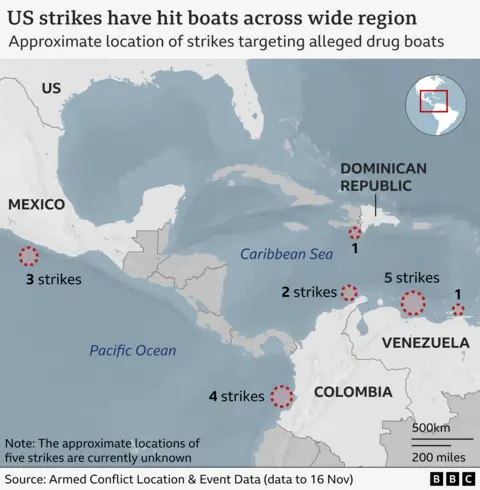Bernd Debusmann Jr.at the White House
 US Southern Command
US Southern CommandUS airstrikes against suspected drug ships in the Caribbean and eastern Pacific have continued unabated since early September in a deadly campaign now dubbed Operation Southern Spear.
The latest strike on Saturday killed three people the US military said were drug smugglers in the Pacific.
Tens of thousands of troops, as well as significant air and naval assets, have been deployed to the region, adding up to the largest U.S. military presence in and around Latin America in decades.
The Trump administration says the strikes are necessary to stop the flow of drugs into the United States.
However, they have sparked controversy and raised fears of wider conflict in the region.
Here's what we know.
Why is the US carrying out strikes?
President Trump and members of his administration have justified the strikes as a necessary anti-drug measure to stem the flow of drugs from Latin America onto US streets.
In a statement, Defense Secretary Pete Hegseth said the campaign, which was officially named Operation Southern Lance on Nov. 13, is aimed at driving “narco-terrorists out of our hemisphere” and protecting the United States from “the drugs that are killing our people.”
However, the Pentagon has officially released little information about the targets or which drug trafficking organizations they allegedly belonged to.
On at least several occasions, Hegseth and several other officials said the targets were linked to the Tren de Aragua, a Venezuelan gang designated a foreign terrorist organization by the Trump administration earlier this year.
It is unclear what impact U.S. officials believe the strikes are having on the broader flow of drugs, much of which crosses the land border between Mexico and the United States.
How many strikes were there?
Between September 2 and November 16, US forces carried out 21 strikes on at least 22 vessels in international waters, both in the Caribbean and in the eastern Pacific.
Most of these strikes occurred off the coast of Venezuela and Colombia.
US Southern Command announced Sunday that its latest strike, carried out Saturday in international waters in the eastern Pacific, killed three “male narco-terrorists” on board.
“Intelligence has confirmed that the vessel was involved in illegal drug smuggling, was following a known drug route and was transporting drugs,” Southern Command wrote in a post on X, along with a video showing the boat exploding in a huge fireball.
In total, at least 83 people died.
Although the US military did not publicly name them, they were all allegedly “narco-terrorists”.
One Associated Press investigation reported that several Venezuelan citizens killed in the strikes were low-level traffickers driven by poverty to a life of crime, as well as at least one local crime lord.

Are these boat strikes legal?
The Trump administration has insisted the strikes are legal, justifying them as necessary self-defense measures to save American lives.
In a confidential note to Congress, the administration said the United States is engaged in an armed conflict with drug cartels that are “unlawful combatants” and whose drug trafficking activities “constitute an armed attack on the United States.”
However, some legal experts said the strikes may be illegal and violate international law because they target civilians without due process of law for the suspects.
Luis Moreno Ocampo, former chief prosecutor at the International Criminal Court (ICC), told the BBC that he believes that strikes can be considered crimes against humanity.
Critics also question whether the White House complied with U.S. law in initially authorizing the strikes.
According to the US Constitution, only Congress has the power to declare war.
In October, President Trump said the US was “allowed” to strike shipping near Venezuela, but that his administration “could go back to Congress” if the campaign was expanded to include targets on land.
“We don’t have to do that,” he said. “But I think… I’d like to do it.”
Is the US preparing to attack Venezuela?
As part of the operation, the United States deployed significant strike power in the Caribbean and western Atlantic within striking distance of Venezuela.
The force includes the aircraft carrier USS Gerald R Ford, as well as a number of guided missile destroyers and amphibious assault ships capable of landing thousands of troops.
In addition, US combat aircraft were deployed to bases in Puerto Rico, and US long-range bombers flew within striking distance of the Venezuelan coastline.
Trump also admitted that he authorized CIA to conduct covert operation in Venezuelaalthough the extent of what this could mean remains highly classified.
The buildup has raised fears that the US is preparing to attack Venezuela directly or potentially try to overthrow the left-wing socialist government of President Nicolas Maduro.
On November 3, Trump downplayed the likelihood of war with Venezuela but suggested that he believed Maduro's days as the country's president were numbered.
When asked whether the United States was going to war against Venezuela, the US president replied on CBS's 60 Minutes: “I doubt it.”
“I don't think so,” he added. “But they treated us very badly.”
How did Maduro react?
Maduro's government has accused the US of stoking tensions in the region with the aim of overthrowing the government.
In response, the Venezuelan military announced readiness exercises and in November announced a “massive mobilization” of troops that sent 200,000 troops across the country.
Maduro warned against US interference in Venezuela and called for peace.
“No more eternal wars. No more unjust wars. There is no more Libya. There is no more Afghanistan,” Maduro said on CNN on November 13. “Long live the world.”








